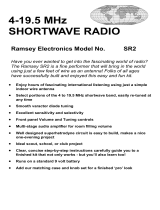Page is loading ...

CRUSH DELAY V3 - ASSEMBLY GUIDE – Rev. Oct 22
THANKS FOR CHOOSING ONE OF OUR KITS!
This assembly guide has been designed taking into account the common issues that we often find people experience in
our workshops. The order in which the components are placed on the board is meant to make assembly as easy as
possible.
Some steps are not obvious, so even if you're an experienced DIYer, please take the time to read the steps thoroughly
before starting. You will be soldering both boards at the same time.
If this is your first project, please read this article before you start assembling the kit: www.befaco.org/howto/
RESISTORS
Color code can be difficult to identify, we strongly recommend to use a multimeter.
Qty
Value
Code
Name on PCB
20
100k
Brown, black, black, orange, brown
R5,R16,R19,R20,R21,R22,R26,R31,R32,R45, R103, R104, R107, R108, R109,
R111, R114, R130, R133, R134
10
680R
Blue, gray, black, black, brown
R1, R2, R8, R14, R15, R23, R25, R55, R62, R65
9
56k
Green, blue, black, red, brown
R9, R11, R12, R13, R18, R106, R115, R119, R123
8
15k
Brown, green, black, red, brown
R24, R36, R53, R54, R60, R66, R101, R120
7
10k
Brown, black, black, red, brown
R27, R30, R47, R49, R51, R56, R64
7
1k
Brown, black, black, brown, brown
R35, R39, R42, R126, R127, R132, R136
6
1M
Brown, black, black, yellow, brown
R3, R4, R6, R7, R128, R129
5
68k
Blue, gray, black, red, brown
R10, R48, R105, R112, R117
4
82k
Gray, red, black, red, brown
R116, R122, R124, R125
3
20k
Red, black, black, red, brown
R44, R46, R68
3
33k
Orange, orange, black, red, brown
R131, R135, R137
2
560k
Green, blue, black, orange, brown
R43, R50
2
270k
Red, purple, black, orange, brown
R28, R113
2
47k
Yellow, violet, black, red, brown
R67, R121
2
6.2k
Blue, red, black, brown, brown
R100, R110
2
680k
Blue, gray, black, orange, brown
R102, R118
1
2M
Red, black, black, yellow, brown
R38
1
470k
Yellow, violet, black, orange, brown
R37
1
330K
Orange, orange, black, orange, brown
R29
1
150k
Brown, green, black, orange, brown
R33
1
120k
Brown, red, black, orange, brown
R52
1
36k
Orange, blue, black, red, brown
R63
1
30k
Orange, black, black, red, brown
R59
1
27k
Red, violet, black, red, brown
R61
1
18k
Brown, gray, black, red, brown
R34
1
12k
Brown, Red, black, red, brown
R17
1
3k
Orange, black, black, brown, brown
R40
1
2.7k
Red, violet, black, brown, brown
R57
1
470 Ohm
Yellow, violet, black, black, brown
R58
1
220 Ohm
Red, red, black, black, brown
R41
1

CRUSH DELAY V3 - ASSEMBLY GUIDE – Rev. Oct 22
DIODES
Solder the diodes observing their polarity. The black or white line on the diode must match with the white line on the
diode symbol on the PCB silkscreen.
Qty
Value
Name on PCB
4
1N4148
D1, D2, D105, D106
4
4.7V
D100, D101, D102, D103
2
2.4V
D3, D4
2
3V
D104, D107
2
1N5817 (Black ones)
D108, D109
FERRITE
Solder the two ferrite beads using a recycled resistor leg passed through each ferrite and proceed as if it were a resistor.
Ferrite beads don't have polarity.
Qty
Name on PCB
2
FERRITE+, FERRITE-
ICs
First place the sockets (taking care to orientate them properly – the notch or dot on one end of the IC should match the
image on the silkscreen) and solder them into their correct positions.
Next place the ICs in their respective sockets (again taking note of their orientation – the notch or dot on the top of the IC
must match that of the socket and silkscreen).
Qty
Value
Name on PCB
5
TL072
IC3, IC4, IC7, IC100 IC101
1
TL074
IC5
1
4053N
IC6
1
PT2399
IC8
2

CRUSH DELAY V3 - ASSEMBLY GUIDE – Rev. Oct 22
CAPACITORS
Identifying capacitors can be quite tricky. Codes stated are indicative, please take a look at this guide for help identifying
capacitors: http://www.wikihow.com/Read-a-Capacitor
Qty
Value
Code
Name on PCB
27
100nF
104
C1, C2, C5, C6, C9, C10, C11, C14, C17, C18, C19, C22,
C26, C28, C30, C35, C36, C38, C39, C42, C43, C100,
C101, C102, C103, C104, C105
10
10p
10
C3, C4, C7, C8, C12, C13, C24, C25, C31, C40
2
560p
561
C33, C37
2
4.7n (Polyester)
4n7k
C27, C44
1
100p
101 / 100
C20
1
10nF (Polyester)
10nk
C34
1
150nF (Polyester)
.15k
C21
ELECTROLYTIC CAPACITORS
Values are written on the side of the capacitor. Mind their polarity (The long leg of the capacitor is the positive (+)).
Qty
Value
Code
Name on PCB
3
10µF
10µF
C16, C106, C107
2
4.7µF
4.7µF
C23, C32
2
1µF
1µF
C15, C41
1
47µF
47µF
C29
TRANSISTORS
Make sure they are positioned correctly as indicated by the silkscreen outline on the PCB.
Qty
Value
Name on PCB
4
2n3904
Q1, Q2, T101, T102
3
2n3906
T1, T100, T103
TRIMMERS
Solder the four 100k trimmers at Offset 1, 2, 3 & 4 with the screw facing out from the edge of the PCB.
3

CRUSH DELAY V3 - ASSEMBLY GUIDE – Rev. Oct 22
PIN HEADER
Place and solder the Pin Headers on the Main Board where the silkscreen indicates “COMPONENTES” (It is the shorter
pins that you are soldering). Double check they all are perfectly straight.
SOCKET CONNECTOR
Place and solder the socket connectors on the control board where the silkscreen indicates “CONTROL”. Double check
they all are perfectly straight.
POWER CONNECTOR
Solder the power connector at “EPOWER”, ensuring it is facing out from the edge of the PCB. The small arrow on the
connectors must be on the side with the thick white line.
Buen trabajo! You’ve already made it quite far through the build. How are your focus and energy
levels? Do you think a 15 minute break would better prepare you for the rest of the build (this is a
big one!)? Maybe you could call someone you haven’t talked to in a while or do something useful like
debate politics on facebook or look at videos of cats being jerks?
SPACERS
Secure the spacers onto Control PCB (through the holes with silver outlines) with the main body of the spacer on the
component side, and the nut on the opposite.
FRONT PANEL COMPONENTS MOUNTING TIPS:
Now we will proceed to mount the jacks, potentiometers and switches. This part of the assembly is CRITICAL. Please take
your time and read the following instructions carefully.
These components must NOT be soldered until they are placed on the PCB and fully attached to the front panel.
There are two reasons for this:
The height of the panel components are not all the same. Because of this, if not attached properly before
soldering, they will not stay properly seated against the panel. This might cause mechanical stress reducing their
life expectancy and in the worst case cause them to break.
The second reason is that it is very difficult to align the components to the holes if the panel is not positioned
prior to soldering. In the case of the LEDs, they are almost impossible to set to the correct height without
reference to the front panel.
4

CRUSH DELAY V3 - ASSEMBLY GUIDE – Rev. Oct 22
MINI-JACKS
Place the mini-jacks on the PCB ensuring they are on the side with the silkscreen side but don't solder them until the
front panel is in place and with all nuts screwed to it. This way it's easier to solder them in the right position. Keep in
mind that the front panel holes are quite narrow and it is almost impossible to place it with all the components already
soldered.
Caution: the switch nuts and the jack nuts looks the same but they are not and will not fit in each others' thread so don't
mix them!.
POTENTIOMETERS
Now place the potentiometer on the PCB. Do not place them all the way down, leave them loose and... don't solder them
yet!
Qty
Type
Name on PCB
5
Single (3pin) 100K
DRY/WET, FEEDBACK, FX_RETURN, IN_TO_DLY, TIME
TOGGLE SWITCHES
Remove the two nuts and the tabbed washer from the toggle switches (if they are still present). Discard one
nut and the tabbed washer, but keep one nut for securing to the front panel later. Place the toggle switches
on the PCB but don't solder them yet.
Qty
Type
Name on PCB
3
Single two position
GATE_1, GATE_2, GATE_3
FRONT PANEL
Attach the front panel adjusting the parts one by one if necessary until they fit. At this point a pair of fine tweezers can
be helpful.
To finish:
- Secure the parts to the panel in this order: A) Mini-jacks B) Switches and C) Pots
- Ensuring all of the above parts are flush with the panel then you can finally solder them!
- Connect the main PCB to the control PCB by threading the 4x M3 screws through the main PCB and securing
them to the 4 spacers. The main PCB should be orientated so that the component side is facing towards the front
panel.
- Put the knobs on the potentiometers and the red end-caps on any switches/faders
- Connect the power ribbon cable: The red wire (-12V) on the power ribbon cable corresponds to pin number
one on the male power connector. The number one pin is indicated with a small triangle on the male power connector
and a white line on the main PCB. A white or black line (or “-12v”) marked on your power bus normally indicates the
corresponding pin.
5

CRUSH DELAY V3 - ASSEMBLY GUIDE – Rev. Oct 22
CALIBRATION
We are now going to calibrate the offset of the VCAs to prevent the CV signal from leaking into the audio
signal.
For this procedure we will use an audio cable to connected to a sound system (not headphones) to listen to
how much CV signal is leaking into our audio path. We will then use the trimmers to reduce this leakage to
a minimum.
Start by unplugging all cables from the front panel. Set “FEEDBACK” to minimum, “TIME” to fast position
and set the three switches in the down position.
Next attach the power connector. We will use a mono audio cable to connect to our test points: the jack tip
(the signal) and jack sleeve (GND). You will need to turn the volume up after connecting as the signal is
quite low. Be careful when connecting/disconnecting to prevent damaging your speakers.
- CV IN calibration.
1- Plug an oscillator into IN VOL CV. Set the IN VOL pot to max and DRY/WET pot to wet position.
Connect an audio cable to TP1 and GND. Turn the trimmer above TP1 until you find the setting with the
least presence of the oscillator.
2- Plug an oscillator into RET VOL CV. Set the RET VOL pot to max and DRY/WET pot to wet position.
Connect an audio cable to TP2 and GND. Turn the trimmer above TP2 until you find the setting with the
least presence of the oscillator.
- DRY/WET Calibration.
Connect an oscillator in DRY/WET CV.
1- Set the DRY/WET Pot to dry position.
Connect an audio cable to TP3 and GND. Turn the trimmer above TP3 until you find the setting with the
least presence of the oscillator.
2- Set the DRY/WET Pot to wet position.
Connect an audio cable to TP4 and GND. Turn the trimmer above TP4 until you find the setting with the
least presence of the oscillator.
ENJOY YOUR NEW BEFACO MODULE!
6

CRUSH DELAY V3 - ASSEMBLY GUIDE – Rev. Oct 22
7

CRUSH DELAY V3 - ASSEMBLY GUIDE – Rev. Oct 22
8
/














